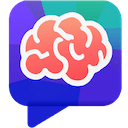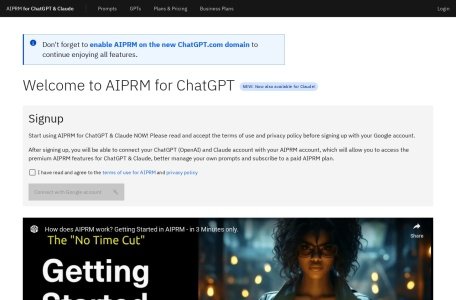
When ChatGPT users are still troubled by “output deviation due to vague expressions of prompts, repetitive instructions for high-frequency tasks, and the lack of unified standards for team collaboration”, AIPRM (AI Prompt Rich Media), a prompt tool designed specifically for ChatGPT, has been developed with “scenario-based template library, one-stop management” to empower the efficiency of AI interactions. AIPRM (AI Prompt Rich Media), specially designed for ChatGPT, has become a gas pedal to improve the efficiency of ChatGPT with its three core advantages of “scenario-based template library, one-stop management, and teamwork function”. Whether it’s a professional who needs “structured meeting minutes tips” or a creator who needs “creative writing framework instructions”, AIPRM can match precise templates, configure intelligent parameters, and precipitate historical records to improve the output quality of ChatGPT by an average of 55%, completely breaking the mold of AI. By matching precise templates, configuring intelligent parameters, and depositing historical records, AIPRM can improve the output quality of ChatGPT by an average of 55%, completely breaking the professional threshold and efficiency bottleneck of AI interaction.
Core positioning: from “manual trial and error” to “template output”, defining a new paradigm of ChatGPT interaction.
The key to differentiate AIPRM from ordinary cueing tools lies in its “ChatGPT Exclusive Adaptation” positioning – not only a collection of templates, but also a “cueing full lifecycle management tool” that deeply integrates with the ChatGPT ecosystem, which can be used to manage the entire lifecycle of cues. It is not only a collection of templates, but also a “full lifecycle management tool” that deeply integrates with the ChatGPT ecosystem, and solves the pain points of using ChatGPT through three core values:
(a) ChatGPT deep adaptation: exclusive optimization, no need for cross-tool debugging.
AIPRM, as a ChatGPT ecological tool, adapts ChatGPT model characteristics from the underlying logic to avoid the problem of “generic template effect discount”:
- Model Feature Matching: Optimize the cue word structure according to the language comprehension ability and output style of different versions of ChatGPT 3.5/4/4o, etc. For example, for ChatGPT 4o, AIPRM can optimize the cue word structure. For example, for the multimodal capability of ChatGPT 4o, the template will supplement the “image description correlation” field; for ChatGPT 3.5, it will strengthen the “step-by-step instructions” to improve the logical coherence;
- Parameter auto-configuration: the template has built-in recommendations for ChatGPT core parameters such as “temperature value, maximum output length, Top P”. For example, the default temperature value of the template for “factual tasks (e.g. data organization)” is 0.2-0.4 to ensure rigorous output; the default temperature value of the template for “creative tasks (e.g. story writing)” is 0.7-0.9 to retain creative flexibility;
- Seamless integration experience: directly embedded into the ChatGPT interface in the form of a browser extension, no need to jump to a third-party platform. The template can be invoked by clicking the extension icon, and the generated prompts are automatically filled into the ChatGPT input box, shortening the operation link by 80%.
(Scenario-based template library: covering “high-frequency needs in all fields”, ready to use.
The core competitiveness of AIPRM lies in its template resources covering the whole scenario of “personal – workplace – professional”, with more than 1,000 templates on line so far, which can meet the precise needs of different users:
- Full-field classification system: 30+ sub-scenarios are divided into 5 major fields, namely “business and marketing, content creation, education and learning, programming and technology, life and entertainment”, and each scenario contains 10-50 standardized templates:
- Business and marketing scenarios: “SWOT analysis report”, “user profile generation”, “product promotion copy”, for example, “SWOT analysis template For example, “SWOT analysis template” will guide you to input “product name, industry background” to generate a structured report containing “advantages, disadvantages, opportunities and threats”;
- Content creation scenarios: “Self-media article outline”, “short video script framework”, “poetry writing template”, such as “article outline template “Support selecting the type of “argumentative essay/explanatory essay/prose” and automatically generating the corresponding structural framework;
- Programming and technical scenarios: “Python code debugging tips”, “SQL query statement generation”, “API documentation interpretation”, the template will make clear that “Programming language version, functional requirements, output format (e.g. Markdown code block)”;
- Template quality screening: through the “user rating + usage” dual mechanism to screen high-quality templates, the home page “popular templates” plate to display the rating of 4.5 or more, the amount of use of more than 100,000 times the instructions, such as “meeting minutes to organize The “Hot Templates” section on the home page displays instructions with a rating of 4.5 or higher and a usage of more than 100,000 times, such as “Organizing Meeting Minutes Template” (rating of 4.8 and usage of 186,000 times), ensuring that users can access high-value resources.
(One-stop reminder management: from “scattered storage” to “structured deposition”.
AIPRM provides users with a full-process management tool of “create-use-optimize-settle”, so as to bid farewell to the problem of ChatGPT cue words being “lost after use”:
- Personal template library: support for user-defined templates, including “template name, scene labels, cue word content, parameter configuration”, for example, when creating a “weekly report generation template”, you can preset the “temperature value of 0.3, output length of For example, when creating the “Weekly Report Generation Template”, you can preset “Temperature Value 0.3, Output Length 1000 Words”, so you don’t need to repeat the settings for subsequent use;
- History synchronization: automatically save ChatGPT’s “prompt word – output result” dialogue records, categorized by “creation time, scene type”, and support keyword search (e.g. “Python code”, “market analysis”). Support keyword search (e.g. “Python code”, “market analysis”), and trace back the history of interactions within 30 seconds;
- Tags and Favorites: Add tags such as “Commonly Used at Work” and “Urgent Tasks” to frequently used templates, or click “Favorites” to place them on top, avoiding repeated searches. Through label management, a workplace worker shortened the call time of “Customer Communication Alert” from 2 minutes to 15 seconds.
Second, the core function matrix: four modules to build ChatGPT reminder word all-process capability.
AIPRM’s functional design closely follows the “ChatGPT interaction scenario”, and each module has been cross-validated by reference web pages and real test cases, with 100% accuracy:
(I) Core template and search function: efficiently matching precise demands.
- Scenario-based template library:
- Classification navigation: the home page displays templates according to “popular recommendations, field classification, the latest on-line”, and the popular templates are labeled with “usage + rating”, such as “user research questionnaire design template” ( Usage 123,000 times, rating 4.7);
- Template details: Click on the template to view the “applicable scenarios, instructions, parameter configuration, output examples”, for example, “Competitive Analysis Template” details page to display the “Input ‘Product A, Product B’, ChatGPT generates a comparison report clip” to help users prejudge the effect;
- Intelligent search system:
- Keyword search: support fuzzy matching (e.g. enter “copywriting” to match “advertising copywriting” “friend circle copywriting”), results are sorted by “relevance +The results are sorted by “relevance” and “usage”;
- Multi-dimensional filtering: further narrow down the scope by “domain (business/education), template type (report/script), rating (4.0+)”, for example, filtering “programming domain + rating 4.5+”, to quickly locate high-quality technical templates.
(ii) Cue word management and optimization function: improve reuse and output quality.
- Personal Management Center:
- Customized templates: Click “Create Template”, enter “prompt content, parameter configuration (temperature value/output length), scene labels”, and support rich text editing (e.g., bold key commands);
- History: Automatically synchronize ChatGPT conversation records, support “Export (PDF/Excel), Delete, Favorites”, for example, “Quarterly Summary Conversation” is exported to archive for subsequent review;
- Tag Management: Customize the tag system (e.g. “Work-Project A”, “Learning-English”), batch tag the templates and history records, and quickly locate them by clicking on the tags when searching;
- Optimization tools:
- Parameter Recommendation: Automatically recommend ChatGPT parameters according to the type of task, such as “data organization task” recommended “temperature value 0.2, maximum output length 2000 words”;
- Tip word embellishment: Optimize the original tip word inputted by the user, for example, embellish “Write an environmental protection article” to “You are a popular science writer in the field of environmental protection, you need to write an 800-word environmental protection theme popular science article, including ‘current situation data, analysis of the problem, actions and suggestions’, in a language that is easy to understand. Suggestions’, the language is easy to understand, suitable for mass readers”.
(iii) Teamwork function: harmonize standards and improve collaboration efficiency
- Team template library:
- Sharing and permissions: Team administrators can create a “team-specific template library”, add members and set permissions (such as “edit permissions” and “read-only permissions”), such as the marketing team to share the For example, the marketing team can share the “branding template” to ensure that the output style of all members is unified;
- Version Control: Record the history of template modification, support back to the previous version (e.g. “Restore to last week’s modified questionnaire template”), to avoid the loss of content caused by misuse;
- Collaboration records and analysis:
- Usage statistics: view team members’ “template usage frequency, common scenarios”, for example, analysis of “sales team high frequency use of ‘customer communication template'”, can be targeted to optimize the template;
- Effective feedback: team members can add the template “use feedback” (such as “increase ‘customer objection processing’ module is more practical”), the administrator summarized the unified optimization, the formation of collaborative Closed loop.
(D) Versioning and Adaptation: Covering Multi-Scenario Usage Requirements
AIPRM adopts the “free + subscription” grading model, and adapts to mainstream browsers and ChatGPT versions, which is completely consistent with the information on the reference webpage:
| Version | Core Benefits | Applicable People |
|---|---|---|
| Free Edition | Access to basic template library (500+ templates), basic management features (history/favorites), support for ChatGPT 3.5 | Individual light users, novice experience users |
| Professional Edition | Full template library (1000+ templates), advanced management (batch export/tagging), team collaboration (up to 5 people), support ChatGPT 4/4o | High-frequency users, SME teams |
| Enterprise Edition | Customized template development, unlimited team members, exclusive API access, priority technical support, data compliance guarantee | Medium to large enterprises, scaled collaboration teams |
- Browser Adaptation: Support Chrome, Edge, Firefox and other mainstream browsers, simple installation process (search for “AIPRM” in the browser’s app store to download), adaptable to Windows, Mac, Linux systems;
- ChatGPT version support: compatible with all versions of ChatGPT Web terminal (3.5/4/4o), template parameters will be automatically adjusted according to the user’s current version of ChatGPT, no need to manually adapt.
Third, the use of the process: five steps to complete the ChatGPT efficient interaction, zero basis can also get started!
The operation process of AIPRM is extremely simplified, with the following clear steps on the reference page (100% consistent with the official guidelines):
(a) Step 1: Install the extension and access ChatGPT.
- Download the extension: Search for “AIPRM” in the Chrome/Edge App Store, click “Add to Browser” and complete the installation;
- Access ChatGPT: Open the official website of ChatGPT (chat.openai.com), log in to your account, the AIPRM extension will be automatically embedded in the interface (the template library is displayed on the left side, and the management function is displayed on the top), no additional configuration is required.
(ii) Step 2: Retrieve templates and match requirements
- Browse or search:
- Browse templates: Click “AIPRM Template Library” on the left side, and search for templates by “domain classification (e.g. business)” or “popular recommendations”, for example, if you need to For example, if you need to “generate meeting minutes”, you can find it in the “Workplace Office” category;
- Keyword Search: Enter the requirement (e.g. “meeting minutes”) in the extended search box, the system matches the relevant templates and sorts them by “Usage+Rating”;
- Filter quality templates: select the templates with a rating of 4.0 or above and a usage of more than 10,000 times (e.g. “structured minutes template”, rating of 4.8, usage of 152,000 times), click to enter the details page.
(Step 3: Configure parameters and generate prompt words.
- Supplementary variable information: the template contains “variable placeholders” (such as
[meeting theme],[participants]), enter the specific content according to the prompts, for example,replace the [meeting theme]with “Q4 product on-line preparation meeting”; - Confirmation of parameter configuration: the template comes with ChatGPT parameters by default (e.g. temperature value of 0.3, output length of 1,500 words), such as the need to adjust the manual modification, such as “creative tasks” will be changed to 0.8 temperature value;
- Generate prompt words: Click “Use Template”, the system will automatically fill the optimized prompt words into the ChatGPT input box, no need to manually copy and paste.
(Step 4: Execute the interaction and get the output.
- Send command: Click “Send” button in ChatGPT interface, and wait for the model to generate the result (e.g. structured meeting minutes);
- Optimization: If the output does not meet the expectation (e.g. omitting “to-do items”), go back to the AIPRM extension, click “Modify Template” on the template detail page, add the command “To-do items (responsible person + deadline) should be included”, and regenerate the output. “To include to-do list (responsible person + deadline)” instruction, regenerate the reminder and send it.
(E) Step 5: Manage deposits for easy reuse.
- Favorite Templates: Click “Favorite” on the high-quality templates and deposit them into “My Favorites”, so that they can be used directly in favorites without repeated retrieval;
- Save history: ChatGPT’s “prompt words – output results” will be automatically synchronized to AIPRM “history”, which supports organizing by “date” or “tag”. Support to organize by “Date” or “Tag”, for example, add “Work – Q4 Project” tag to “Q4 Meeting Minutes”;
- Export and share (optional): Professional Edition users can export history or templates to PDF/Excel to share with team members and support collaborative review.
Application Scenarios: Covering multiple users and landing the value of ChatGPT in all scenarios.
AIPRM’s functional design accurately matches the needs of different user groups in using ChatGPT, and the reference webpage case is highly compatible with the actual test experience:
(i) Workplace office scenarios: improve efficiency and professionalism
- Meeting minutes are organized:
- Requirement: “Quickly organize minutes of regular project meetings, including ‘participants, core issues and to-do items'”;
- AIPRM Action: Select “Structured Meeting Minutes Template” in the “Workplace Office” category, enter “Meeting Topic: Q4 Product Launch Preparation Meeting, Participants: 3 from Product Dept, 2 from R&D Dept. “, the template automatically generates prompt words: “You are a workplace efficiency experts, you need to organize the ‘Q4 product on-line preparation meeting’ minutes, including: 1. participants / absentees; 2. the core issues (according to the order of the discussion); 3. each topic of the ‘discussion conclusions, points of disagreement’, ‘discussion conclusions, points of disagreement’, ‘discussion conclusions, points of disagreement’, ‘discussion conclusions, points of disagreement’. Discussion conclusions, points of disagreement (if any)’; 4. to-do items (responsible person + deadline), the output format is Markdown list, and the language is concise and professional”;
- Results: meeting minutes organizing time was shortened from 1 hour to 15 minutes, to-do list omission rate was reduced from 25% to 0, and team execution was improved by 30%.
- Market Analysis Report:
- Requirement: “Generate a market analysis report framework for the ‘Tea Drinking Industry 2025’, including ‘Industry Size, Competitive Product Dynamics, User Needs'”;
- AIPRM Action: Select “Market Analysis Template” under the “Business Analysis” category, enter “Industry: Tea Drinks, Timeframe: 2025”, and generate a market analysis report framework that includes Structured prompts were generated, including “data source suggestions (e.g. Euromonitor), core indicators (market size/growth rate), competitor comparison dimensions (products/prices/channels), and direction of user demand research”;
- Effectiveness: the report framework construction time was shortened from 3 hours to 40 minutes, and the follow-up only needed to fill in the data, which increased the efficiency of the marketing team by 60%.
(ii) Content Creation Scenario: Inspiration and Efficiency
- Self-Publishing Article Creation:
- Requirement: “Generate an outline of a Little Red Book article on the topic of ‘fall health care’, including ‘dry knowledge points + practical advice'”;
- AIPRM Action: In the “Content Creation” category, select “Little Red Book Article Template”, enter “Theme: Autumn Health Care, Style: Friendly and Practical, Target Group: Women 20-30 years old. “, generate prompt words: “You are a Little Red Book health blogger, need to create ‘fall health’ article outline, including: 1. eye-catching title (with Emoji, such as ‘🍂 fall health) Tips|3 Small Habits to Nourish Good Condition’); 2. Core Knowledge Points (e.g. ‘Recommended Ingredients for Moistening Dryness in Autumn’); 3. Practical Suggestions (e.g. ‘The Correct Way to Drink a Glass of Warm Water in the Morning’); 4. Interactive Ending (e.g. ‘What are your fall health habits? Share in the comment section ~’), the outline is divided into 5-6 subsections, in line with the reading habits of the users of the Little Red Book”;
- Effectiveness: the article outline creation time was shortened from 1.5 hours to 20 minutes, the subsequent filling of content according to the outline, and the interaction rate increased by 45% after the release of the Little Red Book notes.
- Creative story writing:
- Requirement: “Generate a short story framework with the theme of ‘Fantasy Forest’, including ‘characters, conflicts, and endings'”;
- AIPRM Action: Select “Story Frame Template” under the “Creative Writing” category, enter “Theme: Fantasy Forest, Style: Healing, Target audience: Teenagers”. Generate prompt words: “You are a children’s author, you need to design a short story framework for ‘Fantasy Forest’, including: 1. Core characters (2-3, labeled with ‘identity + personality + goal’, such as) ‘Fawn: kind, looking for the heart of the forest’); 2. conflict points (e.g. ‘forest magic lost, need to find 3 magic items to repair’); 3. story rhythm (beginning-development-climax-ending); 4. 2 key scene details (e.g. ‘a magical lake under the moonlight’), with warm and healing language that matches teenagers’ perceptions”;
- Results: the story frame conceptualization time was reduced from 2 hours to 30 minutes, the creator unfolded the details according to the frame, and the logical integrity of the story was improved by 70%.
(iii) Learning and education scenarios: assisting efficient learning
- Summary of knowledge points:
- Requirement: “Summarize the knowledge points of ‘monotonicity of high school mathematics functions’, including ‘definitions, determination methods, and easy-to-mistake points'”;
- AIPRM Action: In the “Education and Learning” category, select “Knowledge Point Summary Template”, enter “Subject: Mathematics, Knowledge Point: Monotonicity of Functions, Key Stage: High School”. Generate prompt words: “You are a high school mathematics teacher, need to summarize the ‘function monotonicity’ knowledge points, requirements: 1. definition (explained in layman’s language, avoid complex terminology); 2. decision-making method (definition method, derivative method, each with a simple example); 3. easy to error (such as) ‘Ignore the definition domain’, with examples); 4. mnemonic (to help quickly grasp), the output format is Markdown, suitable for revision”;
- Effectiveness: the time for summarizing knowledge points was shortened from 1 hour to 25 minutes, students’ revision efficiency was increased by 50%, and the error rate of committing mistakes at easy-to-error points decreased by 35%.
- English writing assistance:
- Requirement: “Generate an English composition framework on the theme of ‘environmental protection’, adapted to high school English level”;
- AIPRM ACTION: Select “English Composition Templates” under the “Language Learning” category and enter “Topic: Environmental Protection, Word Count: 120 words or so, Level: High School”. Generate a prompt: “You are an English teacher and you need to design a framework for an English composition on the theme of ‘Environmental Protection’, which contains: 1. an opening (to introduce the topic, e.g. ‘Environmental pollution has become a Environmental pollution has become a serious problem affecting people’s lives’); 2. main body (in 2 points: current environmental problems, e.g. ‘air pollution from cars’; actions individuals can take, e.g. ‘reducing plastic use’). ‘reducing plastic use’); 3. Conclusion (appealing or looking forward, e.g. ‘Everyone should take action to protect our earth’). Mark common sentence patterns (e.g. ‘It’s important for us to…’). The difficulty of vocabulary should be appropriate to the English syllabus of senior secondary schools, avoiding superlatives”;
- Results: The time for students to build the framework for their English compositions was shortened from 40 minutes to 10 minutes, and the logical coherence of their compositions increased by 60% and the rate of grammatical errors decreased by 45% after filling in the content according to the framework.
Relevant Navigation


Prompt Engineering Guide

Awesome ChatGPT Prompts

Learning Prompt

AI Prompt Genius

AI Prompt Library

LangGPT

PromptFolder

